Identification and Optimization of Urban Avian Ecological Corridors in Kunming: Framework Construction Based on Multi-Model Coupling and Multi-Scenario Simulation
Abstract
1. Introduction
2. Methodology
2.1. Study Area
2.2. Data Sources and Processing
2.2.1. Avian Data
2.2.2. Model Data
2.3. Research Framework
2.4. Identification of Ecological Source Sites
2.4.1. InVEST Ecosystem Services
- (1)
- Soil conservation formula:
- (2)
- Water conservation formula:
- (3)
- Carbon sequestration formula:
- (4)
- Habitat quality formula:
2.4.2. GIS Ecological Sensitivity Analysis
2.4.3. Spatial Pattern Analysis of MSPA Morphology
2.5. Resistance Surface Construction
2.5.1. Resistance Factor Identification
2.5.2. Comprehensive Resistance Surface Construction
2.6. Identification of Ecological Corridors and Ecological Nodes
2.7. Optimize the Ecological Corridor Network
2.7.1. Adding Ecological Stepping Stones
2.7.2. Improvement of Ecological Barrier Sites
2.7.3. Modeling Ecological Pinch Point Degradation
3. Results
3.1. Bird Species and Ecological Source Identification
3.2. Identification of Integrated Resistance Surfaces and Ecological Corridors
3.3. Ecological Corridor Networks for Multi-Scenario Modeling
4. Discussion
4.1. Ecological Source Area Identification Based on a Combination of Factors
4.2. Identification of Ecological Corridors Based on a Combination of Factors
4.2.1. Ecological Corridor Identification
4.2.2. Identifying Ecological Pinch Points and Barriers
4.2.3. Avian Species-Specific Utilization Patterns in Ecological Corridors
4.3. Optimization Strategy Based on Multi-Scenario Simulation
4.3.1. Optimization Strategy Recommendations Under Multi-Scenario Simulation Frameworks
4.3.2. Implementation Pathways for Simulated Optimization Strategies
5. Conclusions
Supplementary Materials
Author Contributions
Funding
Institutional Review Board Statement
Informed Consent Statement
Data Availability Statement
Acknowledgments
Conflicts of Interest
References
- Hilty, J.A.; Keeley, A.T.; Lidicker, W.Z., Jr.; Merenlender. Corridor ecology: Linking landscapes for biodiversity conservation. Trends Ecol. Evol. 2020, 35, 679–690. [Google Scholar]
- Grimm, N.B.; Faeth, S.H.; Golubiewski, N.E.; Redman, C.L.; Wu, J.; Bai, X.; Briggs, J.M. Global change and the ecology of cities. Science 2008, 319, 756–760. [Google Scholar] [CrossRef]
- Grafius, D.R.; Corstanje, R.; Siriwardena, G.M.; Plummer, K.E.; Harris, J.A. A bird’s eye view: Using circuit theory to study urban landscape connectivity for birds. Landsc. Ecol. 2017, 32, 1771–1787. [Google Scholar] [CrossRef]
- Bai, X.; McPhearson, T.; Cleugh, H.; Nagendra, H.; Tong, X.; Zhu, T.; Zhu, Y.G. Linking urbanization and the environment: Conceptual and empirical advances. Annu. Rev. Environ. Resour. 2017, 42, 215–240. [Google Scholar] [CrossRef]
- Tian, Z.Q.; Liu, S.; Gu, P.C.; Lyu, X.; Peng, W.L. Construction of ecological security pattern in Huludao City based on MSPA-MCR-FLUS model. J. Agric. Resour. Environ. 2024, 1–17. [Google Scholar]
- Haddad, N.M.; Brudvig, L.A.; Clobert, J.; Davies, K.F.; Gonzalez, A.; Holt, R.D.; Lovejoy, T.E.; Sexton, J.O.; Austin, M.P.; Collins, C.D.; et al. Habitat fragmentation and its lasting impact on Earth’s ecosystems. Sci. Adv. 2015, 1, e1500052. [Google Scholar] [CrossRef] [PubMed]
- Li, Q.; Chen, J.; Liu, W. A method for constructing ecological corridors across administrative districts. J. Appl. Ecol. 2022, 33, 567–576. [Google Scholar]
- D’Aloia, C.C.; Naujokaitis-Lewis, I.; Blackford, C.; Chu, C.; Curtis, J.M.; Darling, E.; Guichard, F.; Leroux, S.J.; Martensen, A.C.; Rayfield, B.; et al. Coupled networks of permanent protected areas and dynamic conservation areas for biodiversity conservation under climate change. Front. Ecol. Evol. 2019, 7, 27. [Google Scholar] [CrossRef]
- Li, H.; Zhang, Y.; Huang, H.; Chen, F. Ecological network construction in Lushan City based on MSPA and MCR models. J. Cent. South For. Univ. Sci. Technol. 2024, 44, 98–107. [Google Scholar]
- Ye, H.; Yang, Z.; Xu, X. Ecological Corridors Analysis Based on MSPA and MCR Model—A Case Study of the Tomur World Natural Heritage Region. Sustainability 2020, 12, 959. [Google Scholar] [CrossRef]
- Xu, C.; Yu, Q.; Wang, F.; Qiu, S.; Ai, M.; Zhao, J. Identifying and optimizing ecological spatial patterns based on the bird distribution in the Yellow River Basin, China. J. Environ. Manag. 2023, 348, 119293. [Google Scholar] [CrossRef] [PubMed]
- Sun, X.; Shen, J.; Xiao, Y.; Li, S.; Cao, M. Habitat suitability and potential biological corridors for waterbirds in Yancheng coastal wetland of China. Ecol. Indic. 2023, 148, 110090. [Google Scholar] [CrossRef]
- Yang, H.; Xu, W.; Chen, Z.; Xie, X.; Yu, J.; Lei, X.; Guo, S.; Ding, Z. Ecological network construction for bird communities in high-density urban areas: A perspective of integrated approaches. Ecol. Indic. 2024, 158, 111592. [Google Scholar] [CrossRef]
- Lussier, S.M.; Enser, R.W.; Dasilva, S.N.; Charpentier, M. Effects of habitat disturbance from residential development on breeding bird communities in riparian corridors. Environ. Manag. 2006, 38, 504–521. [Google Scholar] [CrossRef] [PubMed]
- Regolin, A.L.; Oliveira-Santos, L.G.; Ribeiro, M.C.; Bailey, L.L. Habitat quality, not habitat amount, drives mammalian habitat use in the Brazilian Pantanal. Landsc. Ecol. 2021, 36, 2519–2533. [Google Scholar] [CrossRef]
- Zhang, L.X.; Chai, B.; Zhang, Y.; He, W.Q.; Tan, X.Q. A comparative study of ecological networks based on gravity modeling and circuit theory—A case study of Jining City. J. Ecol. 2025, 45, 1684–1696. [Google Scholar]
- Zhang, Y.; Yang, L.; Yang, X.; Li, J.; Lan, S.; Yang, J. Avian diversity changes in Kunming urban area (2016–2018). Biodivers. Sci. 2019, 27, 245–253. [Google Scholar]
- Yang, J.; Hu, T.; Li, B.; Zhang, Y.; Li, Y.; Wang, J.; Liu, J. Characteristics of the spatial and temporal evolution of ecological sensitivity in the Dianchi Basin based on the CA-MC model. J. Yunnan Agric. Univ. (Nat. Sci.) 2023, 38, 894–906. [Google Scholar]
- Liu, Q.; Yang, X.; Li, C. Study on the diversity of wintering waterbirds in Kunming Dianchi Wetland. J. Ecol. 2018, 38, 4321–4330. [Google Scholar]
- Yunnan Provincial Department of Ecology and Environment. Yunnan Province Biodiversity Conservation Strategy and Action Plan (2021–2035); Yunnan People’s Publishing House: Kunming, China, 2021.
- Kunming Planning Bureau. Kunming Territorial Spatial Planning (2021–2035); Kunming Planning Bureau: Kunming, China, 2022.
- Yunnan Provincial Forestry Department. Ecological Restoration Planning in Central Yunnan; Yunnan Provincial Forestry Department: Kunming, China, 2023. [Google Scholar]
- Wang, L.; Zhang, Y.; Li, X. Mechanisms of green space fragmentation on bird diversity in the main urban area of Kunming. J. Ecol. 2022, 42, 3125–3136. [Google Scholar]
- Yunnan Institute of Environmental Science. Analysis of the coercive effects of environmental pollution on bird habitats in the main urban area of Kunming. Res. Environ. Sci. 2020, 33, 1021–1030. [Google Scholar]
- Li, Z.Y.; Li, Y.Y.; Li, W.X.; Wang, Y.; Zhang, Y.; Yang, J. Construction of ecological security pattern in Kunming City based on morphological spatial pattern analysis and minimum cumulative resistance model. J. Ecol. Rural. Environ. 2023, 39, 69–79. [Google Scholar]
- Qin, B.G.; Lin, Y.L.; Zhao, J.S.; Zhang, Y.; Yang, J.; Li, W.X.; Wang, Y. Identification of key areas for ecological restoration in Kunming territorial space based on InVEST model and circuit theory. China Environ. Sci. 2023, 43, 809–820. [Google Scholar]
- Ma, J.J.; Phillips, K.; He, F. Field Manual of the Birds of China; Hunan Education Press: Changsha, China, 2000. [Google Scholar]
- Zhengm, G. Classification and Distribution of Birds in China; Science Press: Beijing, China, 2005. [Google Scholar]
- Peng, Q.Q.; Dilinur, A.J.; Li, P.P.; Hu, C.Q.; Kang, J.J.; Wang, K. Spatio-temporal Evolution and Prediction of Carbon Storage in Arid Areas Based on the PLUS-InVEST Model: A Case Study of the Kaidu River Basin. Environ. Sci. 2025, 1–16. [Google Scholar]
- Fang, G.; Shang, B.; Zhao, W.; Zhang, Y.; Yang, J.; Li, W.X.; Wang, Y. Research on soil erosion in the Lhasa River basin based on GIS and RUSLE. J. Soil Water Conserv. 2015, 29, 6–12. [Google Scholar]
- Lu, H.; Huang, Q.; Zhu, J.; Zhang, Y.; Yang, J.; Li, W.X.; Wang, Y. Changes in ecosystem type and quality and their impacts on ecosystem services in the Lhasa River Basin. J. Ecol. 2018, 38, 8911–8918. [Google Scholar]
- Huang, L.; He, C.; Wang, B. Study on the spatial changes concerning ecosystem services value in Lhasa River Basin, China. Environ. Sci. Pollut. Res. 2022, 29, 7827–7843. [Google Scholar] [CrossRef] [PubMed]
- Lv, D.W. Study on the Spatio-Temporal Evolution of Ecosystem Services in the Xinjiang River Basin Based on the InVEST Model; Jiangxi Agricultural University: Nanchang, China, 2022. [Google Scholar]
- Zhao, Y.; He, L.; Bai, W.; He, Z.; Luo, F.; Wang, Z. Prediction of ecological security patterns based on urban expansion: A case study of Chengdu. Ecol. Indic. 2024, 158, 111467. [Google Scholar] [CrossRef]
- Zhu, D.; Xie, B.; Chen, Y. Tourism land use strategy for mountainous tourist cities based on ecological sensitivity evaluation--Taking Zhangjiajie City as an example. Econ. Geogr. 2015, 35, 184–189. [Google Scholar]
- Li, Y.; Guan, C.; Zhu, J. Evaluation of ecological sensitivity of Nebula Lake watershed based on GIS. Res. Soil Water Conserv. 2017, 24, 266–271, 278. [Google Scholar]
- Chen, Y.; Luo, Z.; Qi, S.; Zhang, L.; Wang, X.; Liu, H.; Yang, J. Construction of ecological security pattern in Nanchang based on ecological sensitivity and ecological network. Soil Water Conserv. Res. 2021, 28, 342–349. [Google Scholar]
- Liu, H.; Wang, W.; Wang, Y.; Zhang, Y.; Yang, J.; Li, W.X.; Chen, Y. Comprehensive evaluation of ecological sensitivity and spatial and temporal evolution of the Fen River Basin. J. Ecol. 2021, 41, 3952–3964. [Google Scholar]
- Wang, J.; Chen, M.; Gou, A. Differences in ecological protection red line delineation methods in provincial areas under the goal of one blueprint. Jiangsu Agric. Sci. 2020, 48, 290–297. [Google Scholar]
- Liu, H.; Wang, W.; Wang, Y.; Zhang, Y.; Yang, J.; Li, W.X.; Chen, Y. Evaluation of ecological sensitivity and zoning study of proposed photovoltaic bases in ecologically fragile areas—Taking Qilian County as an example. J. Ecol. 2025, 45, 1–13. [Google Scholar]
- Guo, X.N.; Zhang, X.L.; Du, S.H.; Li, Y.Y.; Wang, J.; Liu, H.; Yang, J. The impact of onshore wind power projects on ecological corridors and landscape connectivity in Shanxi, China. J. Clean. Prod. 2020, 254, 120075. [Google Scholar] [CrossRef]
- Xu, Z.W.; Dong, B.; Wang, C.Y.; Zhang, Y.; Li, W.X.; Liu, H.; Yang, J. Construction of an internationally important wetland White-headed crane ecological corridor in Chongming Dongtan, China. Ecol. Indic. 2023, 149, 110156. [Google Scholar] [CrossRef]
- Seward, A.M.; Beale, C.M.; Gilbert, L.; Jones, T.H.; Thomas, R.J. The impact of increased food availability on the survival of a long-distance migratory bird. Ecology 2013, 94, 221–230. [Google Scholar] [CrossRef]
- Stutchbury, B.J.M.; Tarof, S.A.; Done, T.; Gow, E.; Kramer, P.M.; Tautin, J.; Fox, J.W.; Afanasyev, V. Migratory connectivity of a Neotropical migratory songbird revealed by archival light-level geolocators. Ecol. Appl. 2016, 26, 757–767. [Google Scholar]
- Wei, Z.; Xu, Z.; Dong, B.; Xu, H.; Lu, Z.; Liu, X. Habitat suitability evaluation and ecological corridor construction of wintering cranes in Poyang Lake. Ecol. Eng. 2023, 189, 106894. [Google Scholar] [CrossRef]
- Taubert, F.; Schrodt, F.; Shenkin, A.; Martius, C.J.; Coomes, D.A.; Fischer, R. Global patterns of tropical forest fragmentation. Nature 2018, 554, 519–522. [Google Scholar] [CrossRef]
- Li, Q.; Tang, L.H.; Qiu, Q.Y.; Zhang, L.; Chen, Y.; Lin, J.X.; Lin, Y.B. Construction of urban ecological safety pattern based on morphological spatial pattern analysis and minimum cumulative resistance model—Taking Xiamen City as an example. J. Ecol. 2024, 44, 2284–2294. [Google Scholar]
- Morandi, T.D.; França, J.D.C.L.; Menezes, S.E.; Pinto, A.A.; Carvalho, L.M.T.; Ribeiro, S.C. Delimitation of ecological corridors between conservation units in the Brazilian Cerrado using a GIS and AHP approach. Ecol. Indic. 2020, 115, 106440. [Google Scholar] [CrossRef]
- Shen, X.; Rezaei, T.; Kachenchart, B.; Liu, W.; Li, S.; Chen, Y.; Zhang, L. Optimal region connection: Establishing effective ecological corridors for biodiversity conservation in Yunnan Province, China. Ecol. Indic. 2024, 169, 112918. [Google Scholar] [CrossRef]
- Song, L.L.; Qin, M.Z. Identification of ecological corridors and their importance by integrating circuit theory. Chin. J. Appl. Ecol. 2016, 27, 3344–3352. [Google Scholar]
- Peng, J.; Zhao, H.; Liu, Y. Ecological corridor construction based on least-cost path analysis: A case study of the giant panda in the Qinling Mountains, China. Environ. Manag. 2017, 60, 920–933. [Google Scholar]
- Yang, C.; Xu, M.; Kang, S.; Fu, C.; Hu, D. Improvement of streamflow simulation by combining a physically based hydrological model with deep learning methods in a data-scarce glacial river basin. J. Hydrol. 2023, 625, 129990. [Google Scholar] [CrossRef]
- Hou, Y.; Zhao, W.; Liu, Y.; Yang, S.; Hu, X.; Cherubini, F. Relationships of multiple landscape services and their influencing factors on the Qinghai–Tibet Plateau. Landsc. Ecol 2021, 36, 1987–2005. [Google Scholar] [CrossRef]
- McRae, B.H.; Hall, S.A.; Beier, P.; Theobald, D.M.; Bengsen, A. Where to restore ecological connectivity? Detecting barriers and quantifying restoration benefits. PLoS ONE 2017, 7, e52604. [Google Scholar] [CrossRef]
- Tian, Y.; Zhang, Q.; Huang, H.; Chen, B.; Jia, M.; Wang, D.; Wang, X. Aboveground biomass of typical invasive mangroves and its distribution patterns using UAV-LiDAR data in a subtropical estuary: Maoling River estuary, Guangxi, China. Ecol. Indic. 2022, 136, 108694. [Google Scholar] [CrossRef]
- Huang, G.; Hu, W.; Du, J.; Li, X.; Chen, Y.; Wang, Z.; Zhang, L. Identification and scenario-based optimization of ecological corridor networks for waterbirds in typical coastal wetlands. Ecol. Indic. 2025, 171, 113147. [Google Scholar] [CrossRef]
- Dang, H.; Lü, Y.; Guo, J.; Zhang, L.; Fu, B.; Liu, J.; Wang, X. Multi-scenario simulation can contribute to identifying priorities for regional ecological corridors conservation. Ecol. Indic. 2024, 165, 112166. [Google Scholar] [CrossRef]
- Wang, Z.; Xiao, L.; Yan, H.; Lin, J.; Chen, Y.; Li, X.; Zhang, W. Optimization of the ecological network structure based on scenario simulation and trade-offs/synergies among ecosystem services in nanping. Remote Sens. 2022, 14, 5245. [Google Scholar] [CrossRef]
- Fan, F.; Wen, X.; Feng, Z.; Yang, Y.; Liu, G.; Zhang, J. Optimizing urban ecological space based on the scenario of ecological security patterns: The case of central Wuhan, China. Appl. Geogr. 2022, 138, 102619. [Google Scholar] [CrossRef]
- Luo, X.; Le, F.; Zhang, Y.; Wang, J.; Chen, L.; Liu, Y.; Li, S. Multi-scenario analysis and optimization strategy of ecological security pattern in the Weihe river basin. J. Environ. Manag. 2024, 366, 121813. [Google Scholar] [CrossRef]
- Yang, W.; Ye, H. Identification of ecological networks in the Guangdong-Hong Kong-Macao Greater Bay Area based on habitat quality. J. Ecol. 2023, 43, 10430–10442. [Google Scholar]
- Kong, F.; Duan, S.; Xu, C. Construction of ecological security pattern based on ecosystem services and ecological sensitivity—A case study of Qiantang River Basin. J. Ecol. 2024, 44, 11359–11374. [Google Scholar]
- Qiu, S.; Hu, J.; Yang, H. Construction of ecological security pattern of Li River basin based on ecosystem service and ecological sensitivity evaluation. J. Northwest For. Coll. 2024, 39, 153–162. [Google Scholar]
- Liu, G.; Peng, X.; Su, C. A review of research on the effects of artificial lighting on birds. J. Light. Eng. 2017, 28, 70–76. [Google Scholar]
- Luo, K.; Wu, Z.; Bai, H.; Zhang, L.; Yang, X.; Wang, Y.; Li, D. Bird diversity and waterbird habitat preferences in relation to wetland restoration at Dianchi Lake, south-west China. Avian Res. 2019, 10, 374–385. [Google Scholar] [CrossRef]
- Li, M.; Wang, F.; Chen, L. Effects of urban ecological corridors on bird diversity. J. Ecol. 2020, 40, 4123–4132. [Google Scholar]
- Zhang, W.; Liu, Y.; Wu, P. Research progress on ecological network planning and climate adaptation of urban green space. Landsc. Archit. 2021, 28, 56–63. [Google Scholar]
- Luo, Y.; Zhu, Z.; Wu, J.; Zhang, Y. Exploring habitat patch clusters based on network community detection to identify restored priority areas of ecological networks in urban areas. Urban For. Urban Green. 2022, 78, 127771. [Google Scholar] [CrossRef]
- Huang, X.; Xiu, L.; Lu, Z.; Wang, Y.; Chen, J.; Zhang, K.; Li, M. Ecological networks construction and optimization in the Longdong Loess Plateau: The advantages of self-organizing map and complex networks. Ecol. Indic. 2025, 170, 113138. [Google Scholar] [CrossRef]
- Chen, W.; Chi, G. Urbanization and ecosystem services: The multi-scale spatial spillover effects and spatial variations. Land Use Policy 2022, 114, 105964. [Google Scholar] [CrossRef]
- Kunming Forestry and Grassland Bureau. Report on Dianchi Wetland Ecological Restoration Project; Kunming Forestry and Grassland Bureau: Kunming, China, 2015. [Google Scholar]
- Standing Committee of the Kunming People’s Congress. Regulations on the Protection of Red-billed Gulls in Kunming; Standing Committee of the Kunming People’s Congress: Kunming, China, 2015. [Google Scholar]
- Feng, Y.L.; He, M.; Li, B.; Zhang, W.; Chen, X.; Wang, L.; Liu, Y. Construction and optimization of urban ecological network in main urban area of Chongqing. Ecol. Environ. Sci. 2025, 34, 699–709. [Google Scholar]
- Xiao, Y.; Zhou, X.; Jiang, X.; Wang, L.; Chen, Y.; Zhang, H.; Li, M. Research on ecological security pattern maintenance in Guiyang based on ecosystem service function evaluation. Ecol. Sci. 2020, 39, 244–251. [Google Scholar]
- Li, W.; Zhang, Y.; Chen, X.; Wang, J.; Liu, H.; Yang, S.; Zhou, L. Long-term monitoring of wintering waterbirds in Dianchi Lake. Chin. J. Zool. 2024, 59, 112–120. [Google Scholar]
- Liang, Q.; Zhai, J.; Li, C. From separation to incorporation: Development of a unifying framework that integrates bird habitats with public recreation spaces within the wetland park system. J. Clean. Prod. 2023, 430, 139647. [Google Scholar] [CrossRef]
- Wang, C.; Wang, G.; Dai, L.; Zhang, Y.; Li, X.; Chen, J.; Liu, W. Study on the effect of habitat function change on waterbird diversity and guilds in Yancheng coastal wetlands based on structure–function coupling. Ecol. Indic. 2021, 122, 107223. [Google Scholar] [CrossRef]
- Wang, C.; Wang, G.; Guo, Z.R.; Li, X.; Zhang, Y.; Chen, J.; Liu, W. Effects of land-use change on the distribution of the wintering red-crowned crane (Gnus japonensis) in the coastal area of northern Jiangsu Province, China. Land Use Policy 2020, 90, 104269. [Google Scholar] [CrossRef]
- Zhang, Y.; Li, H.; Wang, J. Spatial heterogeneity and conservation priority of avian habitats in central Yunnan. Landsc. Ecol. 2021, 36, 1123–1136. [Google Scholar]
- Chen, Y.; Liu, M.; Zhao, K. Impacts of urbanization on avian communities in southwest China. Ecol. Indic. 2022, 138, 108843. [Google Scholar]
- Wang, S.; Zhang, L.; Li, M. Ecological sensitivity assessment and conservation priority identification in urbanizing watersheds. Landsc. Ecol. 2021, 36, 1327–1343. [Google Scholar]

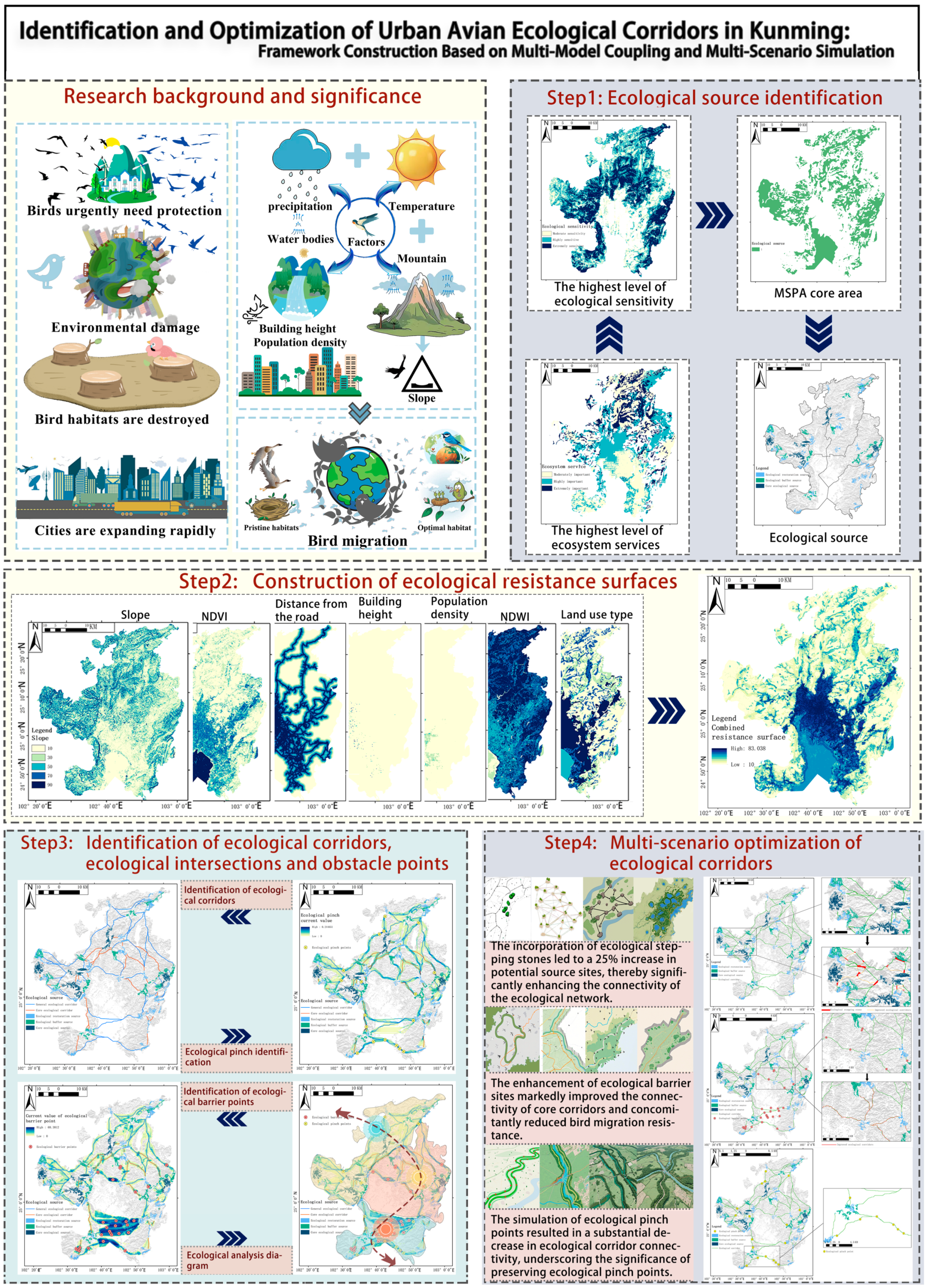


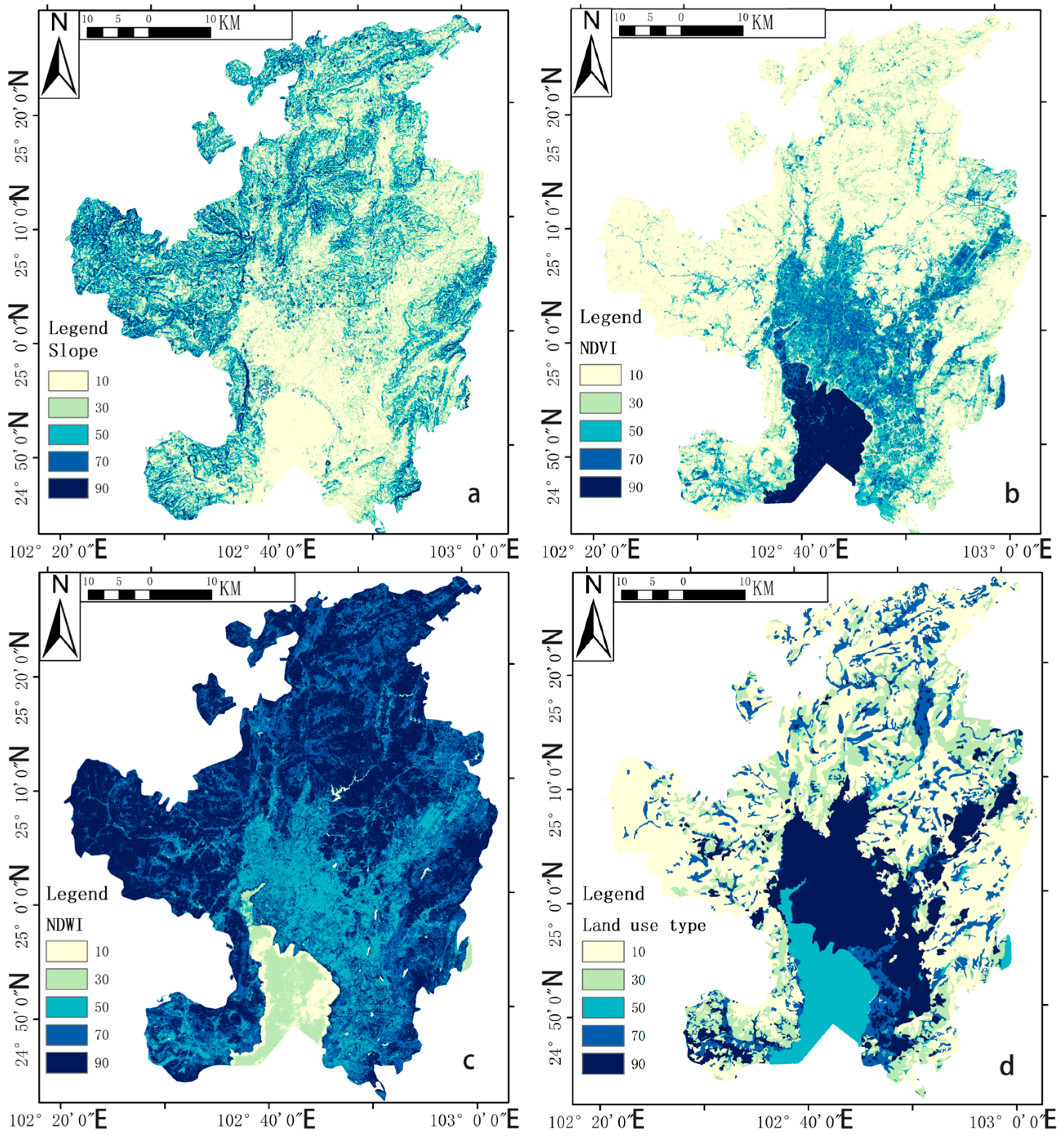


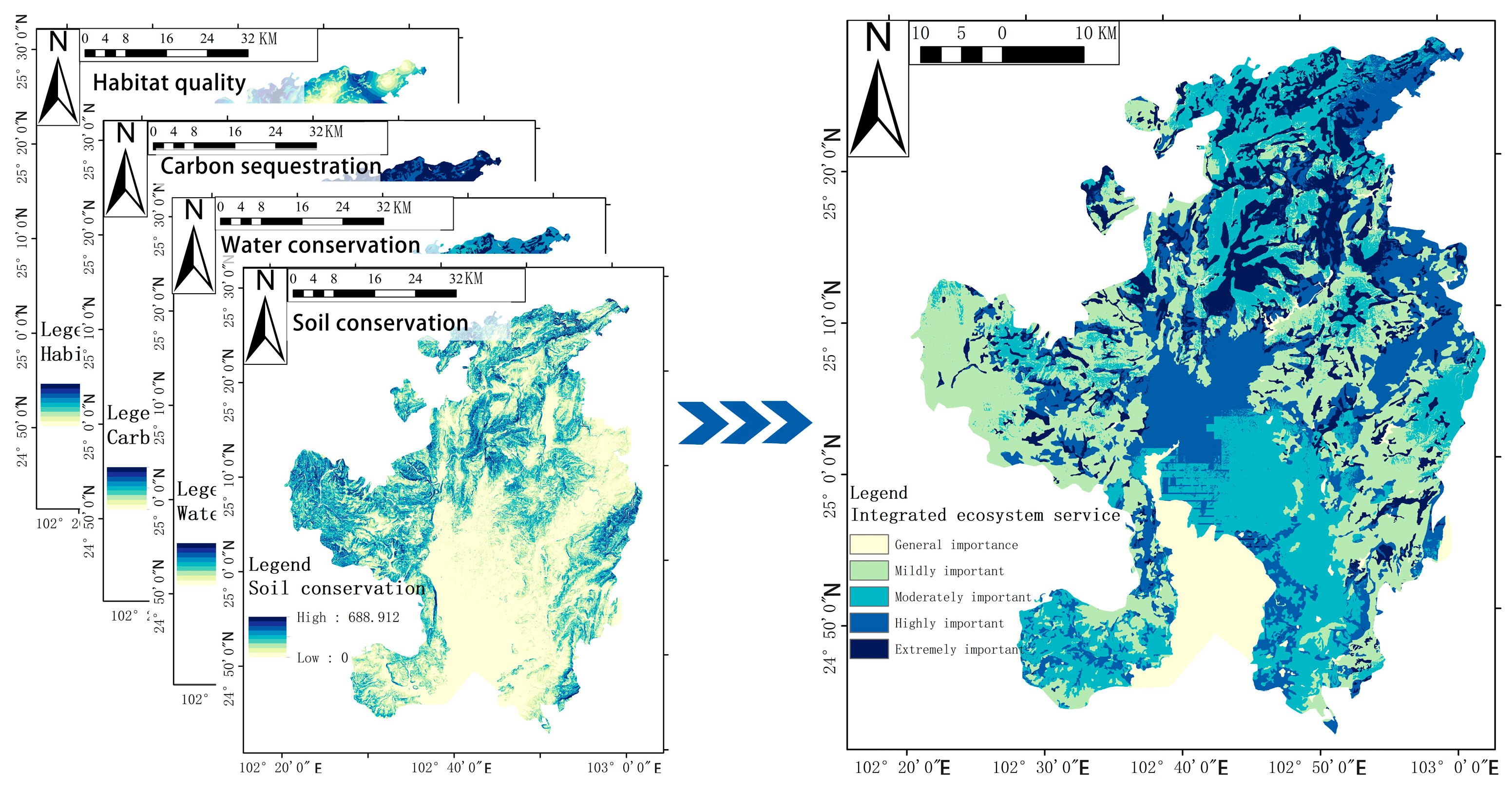

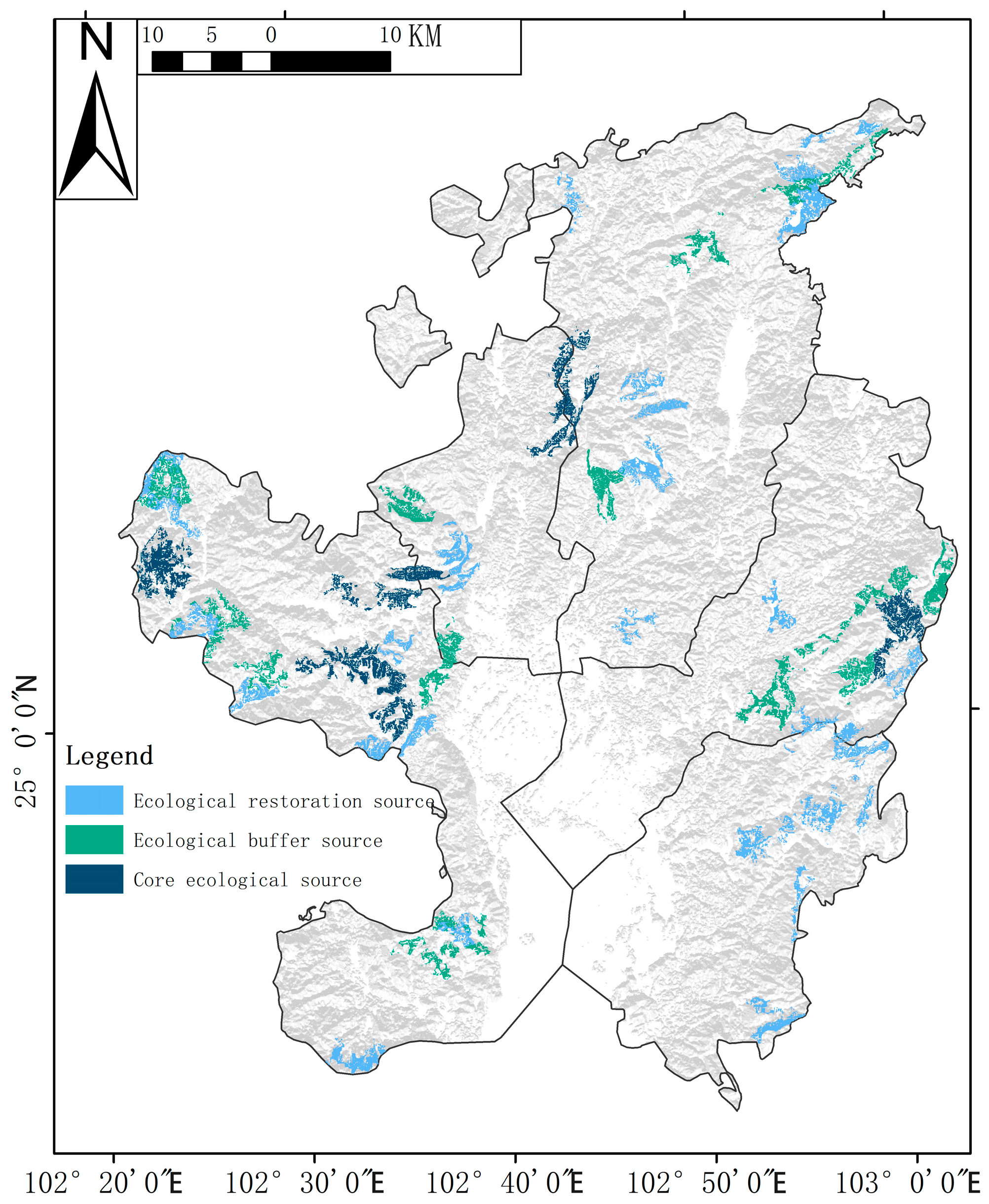
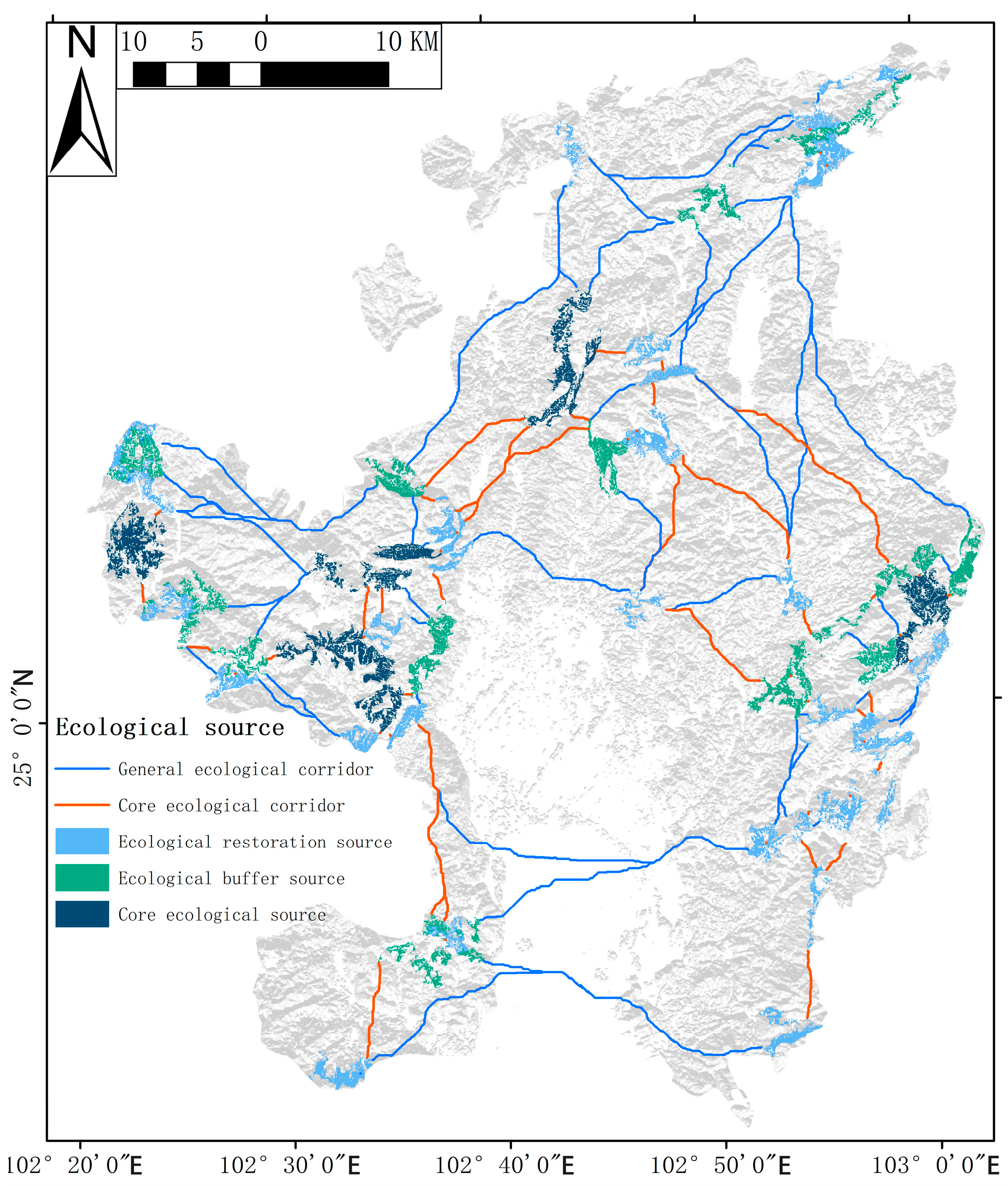
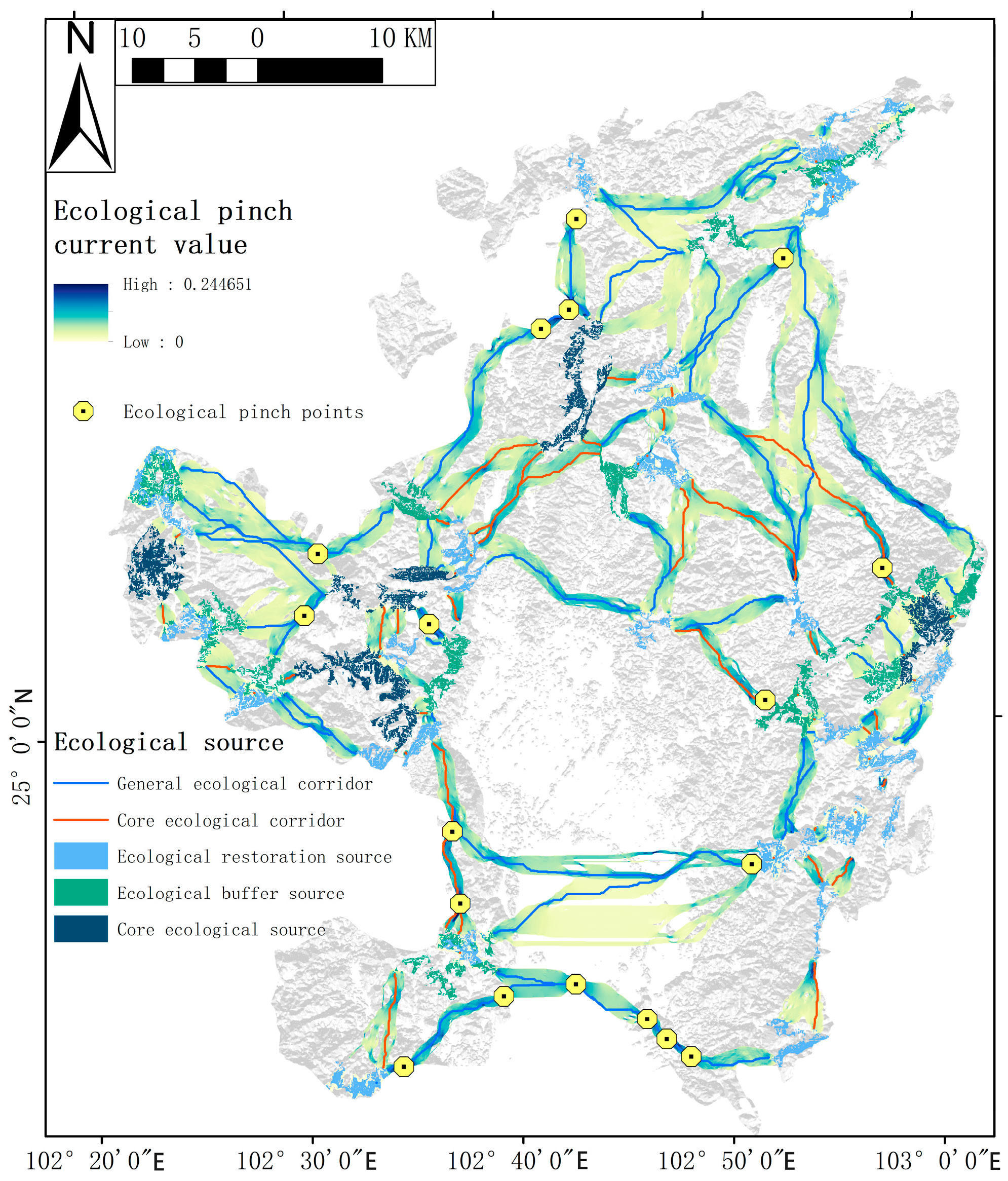
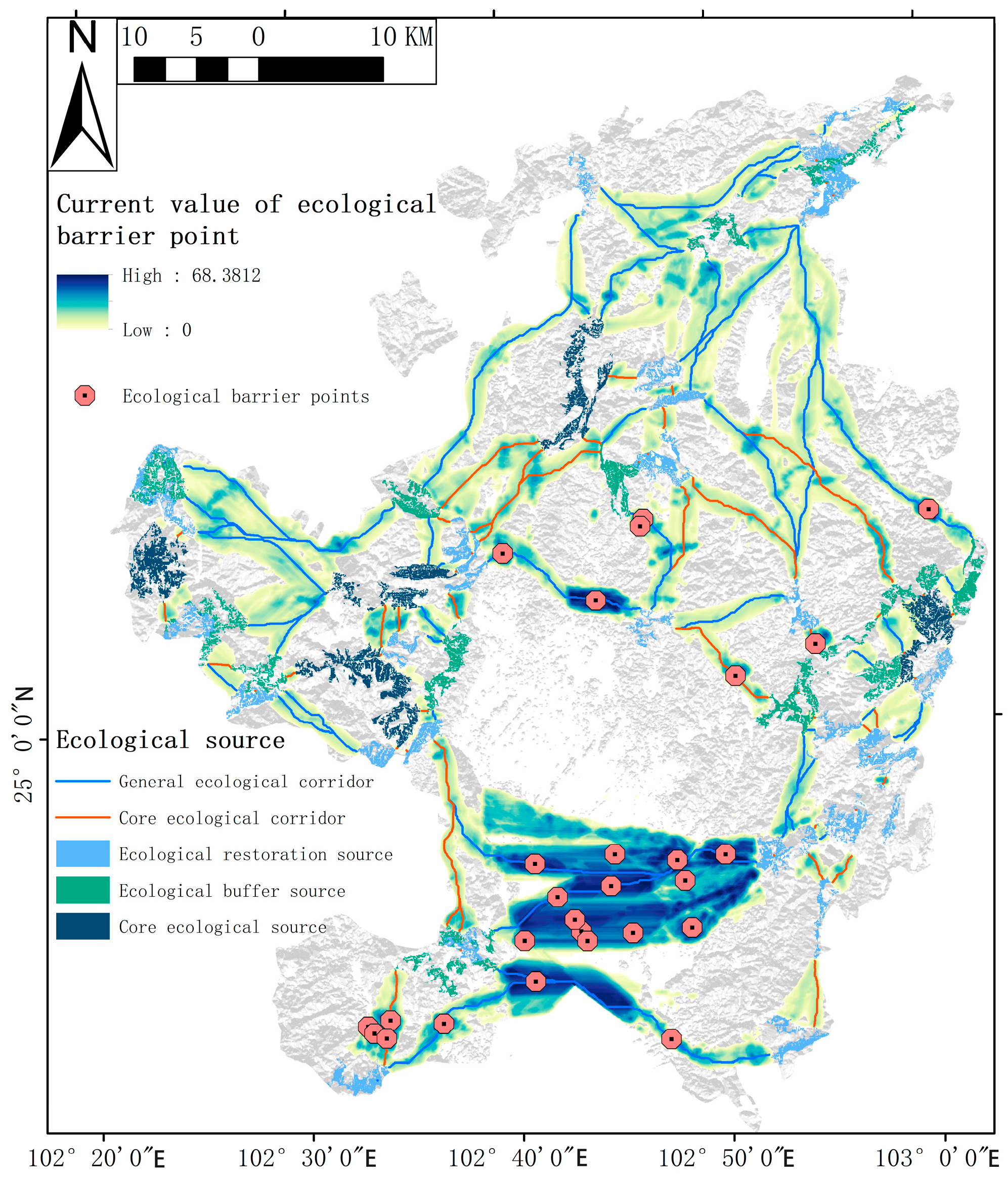
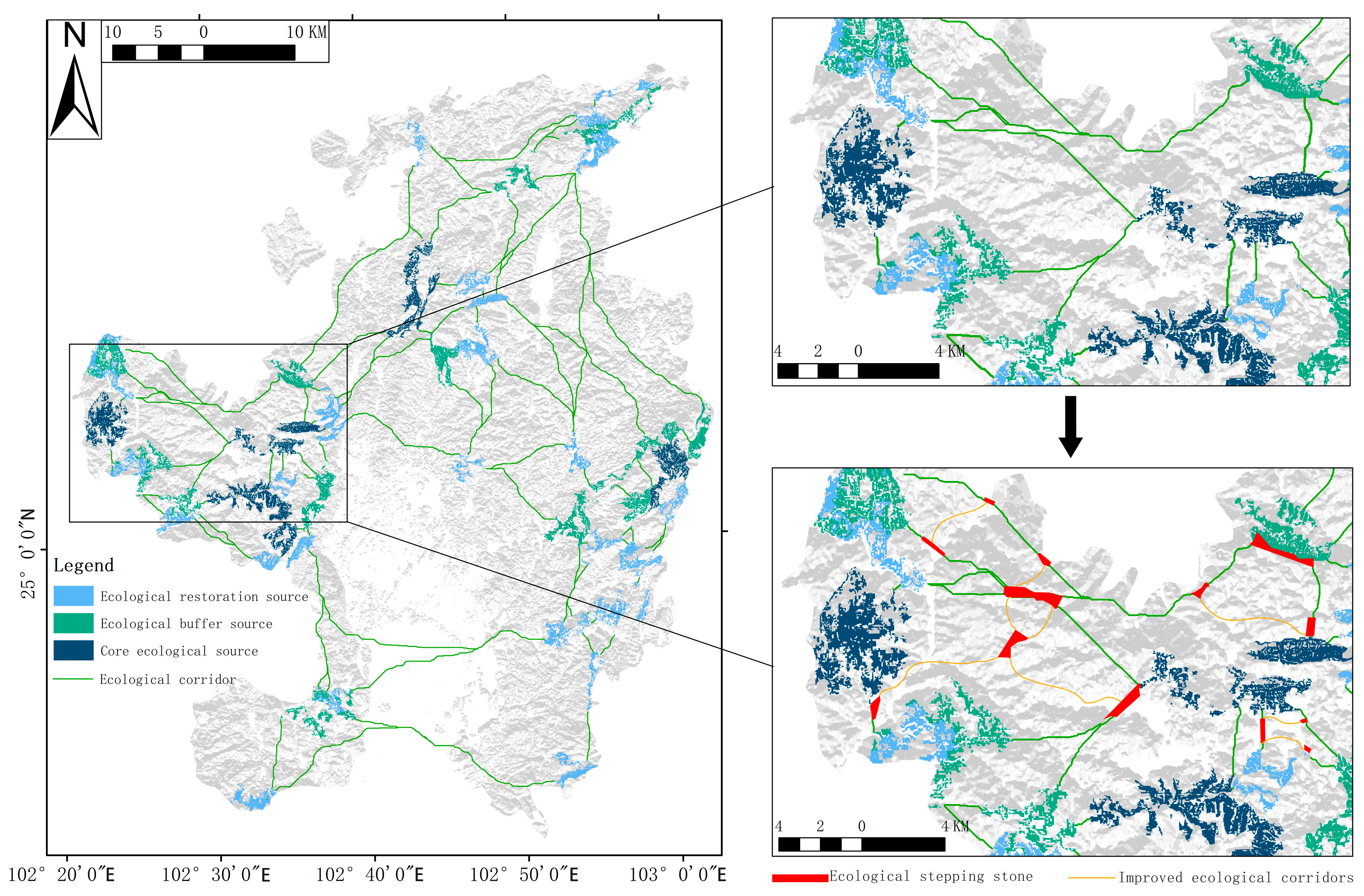

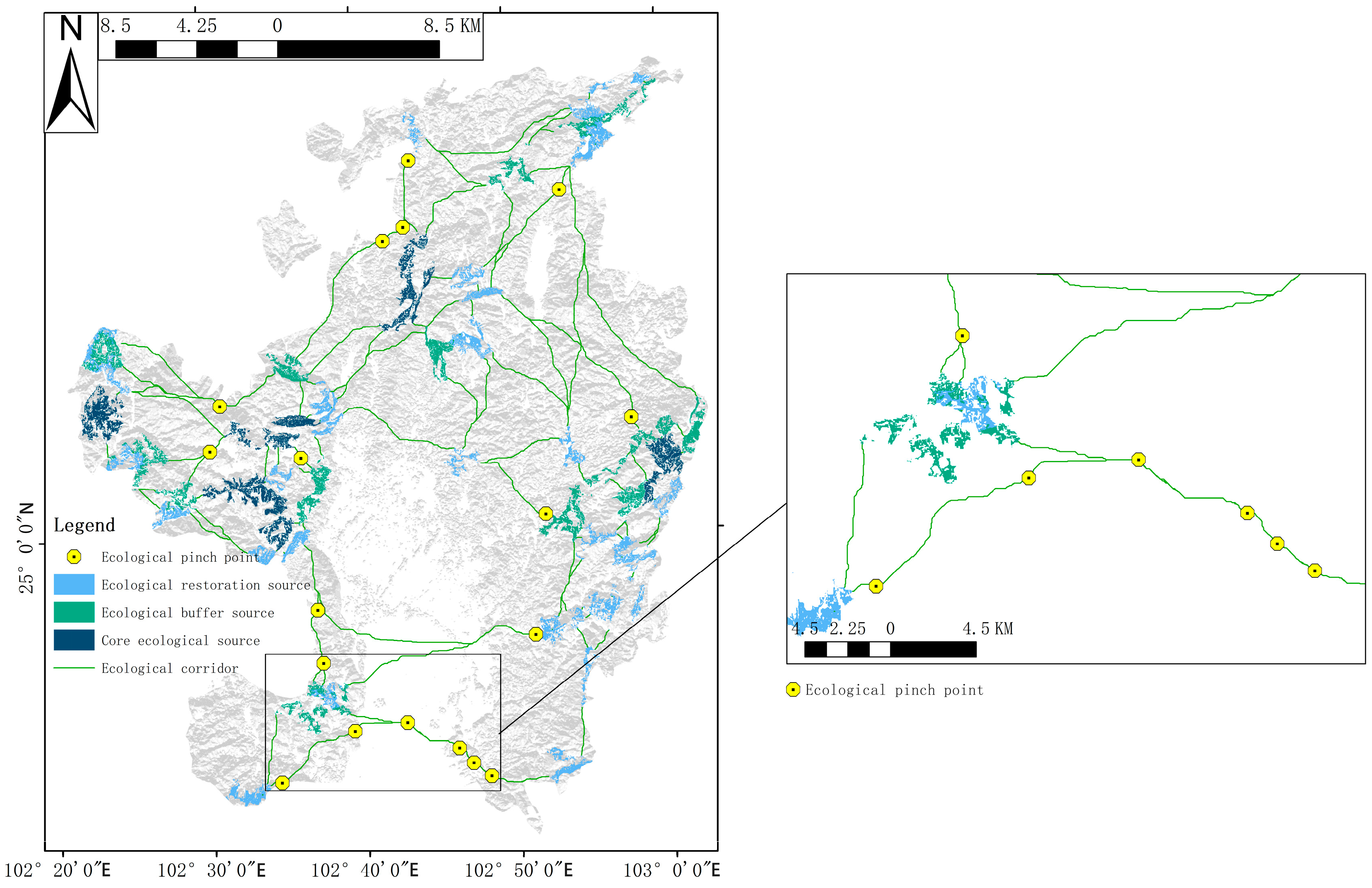
| Urban Green Space Zoning | Number | Sample Name | East Longitude | Northern Latitude | Urban Green Space Zoning | Number | Sample Name | East Longitude | Northern Latitude |
|---|---|---|---|---|---|---|---|---|---|
| Panlong District | 1 | Yunnan map B region | 102.759835 | 25.0876 | Xishan District | 99 | Grand View Park—Yu Garden | 102.675333 | 25.021333 |
| 2 | Kunming Botanical Garden | 102.749253 | 25.144056 | 100 | Lakeside Ecological Wetland Park | 102.669333 | 24.966333 | ||
| 3 | Expo eco-city | 102.767805 | 25.086325 | 101 | Wujiadui Wetland Park | 102.6923 | 24.9963 | ||
| 4 | Golden Hall Park | 102.778053 | 25.091071 | 102 | 300 m northeast of Zhangmei Village Pier | 102.663377 | 24.983377 | ||
| 5 | Kunming Botanical Garden | 102.748829 | 25.148032 | 103 | Kunming West Zhixuan Holiday Inn | 102.679641 | 25.050374 | ||
| 6 | Yunnan Forest Nature Center | 102.808253 | 25.093439 | 104 | Xishan Scenic Spot—Kunming Xishan Forest Park | 102.644333 | 24.993333 | ||
| 7 | Yunnan Academy of Forestry | 102.753463 | 25.151988 | 105 | Panlong River Changlin | 102.695639 | 24.958128 | ||
| 8 | Kunming Branch of the Chinese Academy of Sciences | 102.745373 | 25.143676 | 106 | Grand View Park—Yu Garden | 102.682333 | 24.970333 | ||
| 9 | Kunming Zhongnong Organic Agriculture Certification demonstration base, 100 m west | 102.754738 | 25.11077 | 107 | Lakeside Ecological Wetland Park | 102.694592 | 24.826829 | ||
| 10 | Golden Hall Park | 102.767143 | 25.071602 | 108 | Wujiadui Wetland Park | 102.644333 | 24.993333 | ||
| 11 | Kunming Botanical Garden—Fuli Palace | 102.751077 | 25.086333 | 109 | 300 m northeast of Zhangmei Village Pier | 102.690333 | 24.972333 | ||
| 12 | East Garden of Kunming Botanical Garden | 102.752396 | 25.140271 | 110 | Kunming West Zhixuan Holiday Inn | 102.622333 | 24.973333 | ||
| 13 | Kunming World Horticultural Exposition Park | 102.77101 | 25.059675 | 111 | The Caohai lakeside wetland of Dianchi Lake | 102.675333 | 24.998333 | ||
| 14 | Expo Eco-City South District | 102.770317 | 25.053324 | 112 | Daguan Tower | 102.678377 | 25.023522 | ||
| 15 | World Horticultural Expo Park | 102.77101 | 25.059675 | 113 | Xishan scenic area, Yulan Garden, north | 102.644333 | 24.994333 | ||
| 16 | Waterfall Park | 102.70373 | 25.122392 | 114 | Nie Er Memorial Hall | 102.688333 | 24.975333 | ||
| 17 | Kunming University of Science and Technology Xinying campus | 102.785177 | 25.042776 | 115 | Haigeng dam | 102.692333 | 24.975333 | ||
| 18 | Kunming World Horticultural Exposition Park | 102.77101 | 25.059675 | 116 | No.1 Inpatient Building, The First Affiliated Hospital of Kunming Medical University | 102.690333 | 25.030333 | ||
| 19 | Expo Eco-City Banshan Neighborhood | 102.77021 | 25.05521 | 117 | Longmen Village, Kunming City | 102.640333 | 24.988333 | ||
| 20 | Expo eco-city | 102.770317 | 25.053324 | 118 | Xi Hua Yuan | 102.690813 | 25.028415 | ||
| 21 | Zhujiashan | 102.759143 | 25.050717 | 119 | Longjiang Park | 102.723861 | 24.99614 | ||
| 22 | Huanglongqing Resort | 102.765 | 25.065 | 120 | Huaxia Tianjing Bay | 102.667427 | 24.998344 | ||
| 23 | Jinguishan sightseeing park, bird valley | 102.829457 | 25.091622 | 121 | Haihong Wetland Park | 102.692491 | 24.960412 | ||
| 24 | Longchuan Bridge Forest Park | 102.797045 | 25.141371 | 122 | Avant-garde Road West | 102.699177 | 24.997614 | ||
| 25 | Kunming Institute of Zoology, Chinese Academy of Sciences | 102.7493 | 25.0852 | 123 | Yongchang wetland | 102.659037 | 24.992885 | ||
| 26 | Tanhua Temple (opposite to Jinyuan residential area, Tongxing Group, Tanhua Road) | 102.792 | 25.033 | 124 | The famous city of Biji | 102.677076 | 25.041194 | ||
| 27 | Tuanshan | 102.781222 | 25.208543 | 125 | Fivestars Garden | 102.675867 | 25.048306 | ||
| 28 | Manzhewa | 102.786343 | 25.076714 | 126 | Grand View Park South Garden | 102.677333 | 25.022333 | ||
| 29 | Kunming Botanical Garden West Garden | 102.748863 | 25.144512 | Cheng gong District | 127 | Jiangwei | 102.790998 | 24.883766 | |
| 30 | Kunming University of Science and Technology Xinying Campus | 102.785177 | 25.042776 | 128 | Wulong Chuen Temple | 102.79385 | 24.863009 | ||
| 31 | Yingchun Yayuan ecological villa | 102.831162 | 25.099388 | 129 | Ancient Dian Boutique Wetland Park | 102.751338 | 24.779033 | ||
| 32 | Zhujiashan, Shuanglong Street | 102.759143 | 25.050717 | 130 | Along the fishing river | 102.778945 | 24.829072 | ||
| 33 | Yunnan Fengzeyuan Botanical Garden | 102.698343 | 25.114343 | 131 | Yunnan University Zehu | 102.851535 | 24.837137 | ||
| 34 | Huanglongtan Ecological Park | 102.868108 | 25.246757 | 132 | Xinghu Bay | 102.800875 | 24.864377 | ||
| 35 | Songhuaba Reservoir | 102.714722 | 25.145556 | 133 | Lao Yu River Wetland Park | 102.776119 | 24.827499 | ||
| 36 | Bailongtan | 102.843908 | 25.233517 | 134 | Yunnan University Lixian Building | 102.855585 | 24.838663 | ||
| 37 | Kunming University of Science and Technology | 102.785177 | 25.042776 | 135 | Guangtian East Road, Yunnan University | 102.859031 | 24.836355 | ||
| 38 | Tanhua Temple Park | 102.791997 | 25.033334 | 136 | Dounan wetland | 102.774341 | 24.900178 | ||
| 39 | Jindian reservoir | 102.764333 | 25.079333 | 137 | Yunnan University Zehu | 102.851535 | 24.837137 | ||
| 40 | Bailongt | 102.783333 | 25.028333 | 138 | Dounan street Jiangwei village | 102.788673 | 24.882152 | ||
| 41 | Dianwei Village | 102.745333 | 25.111333 | 139 | Jiangwei Village | 102.790998 | 24.883766 | ||
| 42 | Southwest Forestry University arboretum | 102.779167 | 25.046389 | 140 | Dounan Street house bay | 102.783357 | 24.88355 | ||
| 43 | Black Dragon Pool Park | 102.757024 | 25.148149 | 141 | University Station Metro Station | 102.773314 | 24.925233 | ||
| 44 | Jindian Forest Park | 102.777899 | 25.090123 | 142 | Dounan street Jiangwei village | 102.763737 | 24.976697 | ||
| 45 | Waterfall Park | 102.771 | 25.133329 | 143 | Yupu Cold Spring Forest Ecological Wetland Park | 102.773337 | 24.907337 | ||
| 46 | Tanhua Temple | 102.75633 | 25.052291 | 144 | College station | 102.773333 | 24.92 | ||
| 47 | Baiyi Temple | 102.746359 | 25.069727 | 145 | Ma Jinpu Street, Yangliuchong | 102.678363 | 24.894337 | ||
| 48 | Low-carbon center | 102.763289 | 25.087632 | 146 | Yangwangsan | 102.673333 | 24.946667 | ||
| 49 | Drum Tower Park | 102.718834 | 25.053474 | 147 | Venice Hotel Kunming | 102.816895 | 24.787264 | ||
| 50 | The Golden Juice River Bridge | 102.757703 | 25.120348 | 148 | Dounan street office, Jiangwei community neighborhood committee | 102.763737 | 24.976697 | ||
| 51 | Sunflower Commune | 102.726586 | 25.080815 | 149 | Lo Yu River | 102.778945 | 24.829072 | ||
| 52 | Muyang River | 102.822972 | 25.297208 | 150 | Tuyere village | 102.694772 | 24.944693 | ||
| Wuhua District | 53 | Cuihu Park | 102.710169 | 25.054743 | 151 | Yunnan University | 102.77314 | 24.922237 | |
| 54 | Maitreya Temple Park | 102.705649 | 25.036663 | 152 | Along the fishing river | 102.779132 | 24.830684 | ||
| 55 | Lotus Pond | 102.707553 | 25.067459 | 153 | Lorong Park | 102.825836 | 24.895635 | ||
| 56 | Changzhong Mountain Ecological Park | 102.711363 | 25.120145 | 154 | Ginkgo Park | 102.82764 | 24.779937 | ||
| 57 | Kunming Zoo | 102.71679 | 25.059918 | 155 | Yupu Park | 102.823795 | 24.79626 | ||
| 58 | North City Lotus Pond Moonlight west | 102.728565 | 25.099512 | 156 | TV tower line | 102.879208 | 24.757029 | ||
| 59 | Crescent Lake Park | 102.732874 | 25.096864 | 157 | Municipal administrative center | 102.842814 | 24.884307 | ||
| 60 | Kunming Zoo—Yutong Mountain | 102.717712 | 25.058963 | 158 | The Fish River Park | 102.776119 | 24.827499 | ||
| 61 | Forest Hubei 150 m | 102.635483 | 24.962334 | 159 | Blue Light Joy City | 102.780818 | 24.89808 | ||
| 62 | Kunming Zoo, 50 m northeast of Yuantong Mountain | 102.708372 | 25.049627 | 160 | Langxi Street | 102.87024 | 24.854228 | ||
| 63 | Jinniu Park | 102.700293 | 25.042605 | 161 | Luoyang Street | 102.837082 | 24.908072 | ||
| 64 | Yunnan Provincial People’s Government | 102.70293 | 25.041619 | 162 | Dounan Wetland Park | 102.774341 | 24.900178 | ||
| 65 | Garden | 102.637703 | 25.120856 | 163 | Haiyan Village | 102.73339 | 24.947333 | ||
| 66 | Donglu Campus of Yunnan University | 102.700609 | 25.034834 | 164 | Xinghu Bay (No.258 Haihu Road, Kunming) | 102.673312 | 24.872537 | ||
| 67 | West Zhuahene Street Pear Pass | 102.60706 | 25.11639 | Guandu District | 165 | Kunming Haidong Wetland Park | 102.736942 | 24.927936 | |
| 68 | Hongpo Reservoir | 102.6693 | 25.0623 | 166 | Baofeng Wetland Park | 102.73292 | 24.933701 | ||
| 69 | Yuantong Mountain Zoo | 102.708062 | 25.04926 | 167 | Guandu Street Baofeng | 102.729607 | 24.936855 | ||
| 70 | Lihuaqing | 102.60706 | 25.11639 | 168 | Baofeng | 102.729595 | 24.936318 | ||
| 71 | Countrypark | 102.624433 | 25.074668 | 169 | Guandu Street Baofeng village | 102.727086 | 24.936163 | ||
| 72 | Saikyoji | 102.745885 | 25.114013 | 170 | Baofeng Wetland Park—Baoxang River into the lake estuary wetland | 102.731816 | 24.928483 | ||
| 73 | Bozhong Garden | 102.683735 | 25.095646 | 171 | Xinghai Peninsula Wetland Park | 102.694296 | 24.952984 | ||
| 74 | Jintai International | 102.679877 | 25.069866 | 172 | Kunming Dianchi Baofeng Wetland Park | 102.732189 | 24.93396 | ||
| 75 | Crystal Seol | 102.704204 | 25.079893 | 173 | Liujia street, Qinghe village | 102.691026 | 24.942453 | ||
| 76 | Wuhua Plaza | 102.712544 | 25.050389 | 174 | Fubao wetland | 102.701151 | 24.936674 | ||
| 77 | Sumishan Park | 102.664352 | 25.097941 | 175 | Kunming Xinghai Peninsula Wetland Park | 102.694296 | 24.952984 | ||
| 78 | Crescent Lake Park | 102.732874 | 25.096864 | 176 | Kunming Dianchi Baofeng Wetland Park | 102.708349 | 24.929352 | ||
| 79 | Kunming Zoo (92 Qingnian Road, Kunming City) | 102.708062 | 25.04926 | 177 | Baofeng Wetland Park | 102.708349 | 24.929352 | ||
| Xishan District | 80 | News Road Book Market (News Road Store) | 102.694816 | 25.040655 | 178 | Changshui Airport | 102.97577 | 25.119272 | |
| 81 | Kunming Dianchi National Tourism Resort | 102.6706 | 24.988083 | 179 | Baofeng Side | 102.708349 | 24.929352 | ||
| 82 | Huiwan wetland | 102.656761 | 24.914068 | 180 | Helen International, 4 Hyde area | 102.739067 | 24.902235 | ||
| 83 | Longniwan | 102.652541 | 24.791456 | 181 | Haidong Wetland Park | 102.719394 | 24.923222 | ||
| 84 | Hongjia Village | 102.695535 | 24.957482 | 182 | Kunming Dianchi Baofeng Wetland Park | 102.708349 | 24.929352 | ||
| 85 | Baozhu Ecological Park | 102.633451 | 25.045769 | 183 | Light Flight Collection Hotel Kunming | 102.927431 | 25.122292 | ||
| 86 | Light Bay | 102.649002 | 24.925581 | 184 | Baofeng Wetland Park—Baoxang River into the lake estuary wetland | 102.708349 | 24.929352 | ||
| 87 | Haigeng Park | 102.665263 | 24.966196 | 185 | Guandu Forest Park | 102.757755 | 25.014273 | ||
| 88 | Biji Road (North of Lehaiche City) | 102.631499 | 25.000938 | 186 | Helen International | 102.739067 | 24.902235 | ||
| 89 | Caohai tunnel | 102.672041 | 25.017698 | 187 | Xiliangtang Wetland | 102.742937 | 24.941968 | ||
| 90 | Scenic Road (inside Dianchi Dam) | 102.656928 | 24.987938 | 188 | Ruyi Park | 102.759789 | 24.971024 | ||
| 91 | Biji Road (East of Education and Training Center of Kunming Transportation Bureau) | 102.636284 | 25.014742 | 189 | Dongjiawan | 102.745758 | 25.041025 | ||
| 92 | Hongjia Village | 102.665 | 25.023 | 190 | Jerlin Park | 102.732438 | 25.028173 | ||
| 93 | Yunnan Highway development and Investment Company, Kunming west management office, east | 102.634121 | 25.005992 | 191 | Romma Road | 102.731312 | 24.941083 | ||
| 94 | Ma Street, Puping village | 102.639 | 25.021 | 192 | Dongxu Juncheng | 102.786878 | 25.033786 | ||
| 95 | Kunming Sunac Sea World | 102.629 | 25.005 | 193 | Shut down the rule of law | 102.741398 | 25.031417 | ||
| 96 | Kunming Daguan Park—South Garden | 102.677333 | 25.022333 | 194 | Jinshu Spring Ribbon Park | 102.746014 | 25.045171 | ||
| 97 | Dianchi Fortress-Ziying (South of Wanda Avenue) | 102.673333 | 24.970333 | 195 | New house | 102.734323 | 24.904333 | ||
| 98 | Lakeside Ecological Wetland Park | 102.669333 | 24.966333 |
| Classification Basis | Avian Species | Percentage (%) | Typical Species |
|---|---|---|---|
| Migratory behavior | Resident bird | 64.72% | Pycnonotus xanthorrhous, Passer domesticus, Egretta garzetta |
| Migratory bird | 35.28% | Chroicocephalus ridibundus, Hirundo rustica, Phylloscopus proregulus | |
| Habitat preference | Woodland birds | 39.87% | Pycnonotus xanthorrhous, Aegithalos concinnus, Zosterops japonicus |
| Wetland birds | 37.63% | Chroicocephalus ridibundus, Egretta garzetta, Motacilla alba | |
| Open-country Birds | 22.50% | Passer domesticus, Pycnonotus aurigaster, Copsychus saularis | |
| Migratory ability | Low-mobility Species | 47.29% | Pycnonotus xanthorrhous, Passer domesticus, Aegithalos concinnus |
| Moderate migrants | 9.19% | Gallinula chloropus, Motacilla alba, Zosterops japonicus | |
| Long-distance migrants | 43.52% | Chroicocephalus ridibundus, Egretta garzetta, Hirundo rustica |
| Digital Model | Data Classification | Data Type | Data Source | Spatial Resolution |
|---|---|---|---|---|
| InVEST Ecosystem Services | \ | Land use type | Data Center for Resources and Environmental Sciences, Chinese Academy of Sciences (https://www.resdc.cn/) | 30 m |
| Traffic network | 1 km | |||
| Watershed boundary | 1 km | |||
| Density of the river network | \ | |||
| Evaporation capacity | \ | |||
| Precipitation | \ | |||
| Ecological sensitivity of GIS | Climate sensitivity | Mean air temperature | Data Center for Resources and Environmental Sciences, Chinese Academy of Sciences (https://www.resdc.cn/) | 1 km |
| Relative humidity | 1 km | |||
| Mean annual precipitation | National Oceanic and Atmospheric Administration (https://www.noaa.gov/) | 1 km | ||
| Geological sensitivity | Elevation | Geospatial Data Cloud (http://www.gscloud.cn/) | 30 m | |
| Slope | Based on elevation data extracted from ArcGIS | 30 m | ||
| Aspect of slope | 30 m | |||
| Relief of relief | 30 m | |||
| Topographic roughness | 30 m | |||
| Surface cutting depth | 30 m | |||
| Natural resource sensitivity | Stream density buffer | Based on elevation data extracted from ArcGIS | 30 m | |
| Lake extent | Geospatial Data Cloud (http://www.gscloud.cn/) | 30 m | ||
| Soil type | Data Center for Resources and Environmental Sciences, Chinese | 30 m | ||
| Land use type | 30 m | |||
| Vegetation coverage | National Data Center for Ecological Sciences (http://www.nesdc.org.cn/) | 30 m | ||
| Human interference sensitivity | Road density | Data Center for Resources and Environmental Sciences, Chinese Academy of Sciences (https://www.resdc.cn/) | 30 m | |
| Population density | ORNL Landscn (https://landscan.ornl.gov/citations (accessed on 10 June 2025)) | 30 m | ||
| Morphological spatial analysis of MSPA | / | Land use type | Data Center for Resources and Environmental Sciences, Chinese Academy of Sciences (https://www.resdc.cn/) | 30 m |
| Resistance Factors | Resistance Value | Drag Coefficient | Weight |
|---|---|---|---|
| Slope | 0–6.09 | 10 | 0.0268 |
| 6.09–13.06 | 30 | ||
| 13.06–21.19 | 50 | ||
| 21.19–31.92 | 70 | ||
| 31.92–74.30 | 90 | ||
| NDVI | 7893–9999 | 10 | 0.3302 |
| 6021–7893 | 30 | ||
| 3704–6021 | 50 | ||
| 797–3704 | 70 | ||
| −3698–797 | 90 | ||
| NDWI | 0.40–0.89 | 10 | 0.0348 |
| 0.06–0.40 | 30 | ||
| −0.33–0.06 | 50 | ||
| −0.55 + 0.33 | 70 | ||
| −0.86 + 0.55 | 90 | ||
| Land use type | Forest land | 10 | 0.3257 |
| Meadow | 30 | ||
| Waters | 50 | ||
| Plowland | 70 | ||
| Residential land | 90 | ||
| Distance from the road | >1500 m | 10 | 0.1112 |
| 1000–1500 m | 30 | ||
| 500–1000 m | 50 | ||
| 200–500 m | 70 | ||
| <200 m | 90 | ||
| Building height | 3.50–14 m | 10 | 0.0467 |
| 14–31.5 m | 30 | ||
| 31.5–56 m | 50 | ||
| 56–91 m | 70 | ||
| 91–140 m | 90 | ||
| Population density | 0.04–27.79 | 10 | 0.1246 |
| 27.79–104.11 | 30 | ||
| 104.11–360.82 | 50 | ||
| 360.82–825.68 | 70 | ||
| 825.68–1776.20 | 90 |
Disclaimer/Publisher’s Note: The statements, opinions and data contained in all publications are solely those of the individual author(s) and contributor(s) and not of MDPI and/or the editor(s). MDPI and/or the editor(s) disclaim responsibility for any injury to people or property resulting from any ideas, methods, instructions or products referred to in the content. |
© 2025 by the authors. Licensee MDPI, Basel, Switzerland. This article is an open access article distributed under the terms and conditions of the Creative Commons Attribution (CC BY) license (https://creativecommons.org/licenses/by/4.0/).
Share and Cite
Zhang, X.; Zhang, Z. Identification and Optimization of Urban Avian Ecological Corridors in Kunming: Framework Construction Based on Multi-Model Coupling and Multi-Scenario Simulation. Diversity 2025, 17, 427. https://doi.org/10.3390/d17060427
Zhang X, Zhang Z. Identification and Optimization of Urban Avian Ecological Corridors in Kunming: Framework Construction Based on Multi-Model Coupling and Multi-Scenario Simulation. Diversity. 2025; 17(6):427. https://doi.org/10.3390/d17060427
Chicago/Turabian StyleZhang, Xiaoli, and Zhe Zhang. 2025. "Identification and Optimization of Urban Avian Ecological Corridors in Kunming: Framework Construction Based on Multi-Model Coupling and Multi-Scenario Simulation" Diversity 17, no. 6: 427. https://doi.org/10.3390/d17060427
APA StyleZhang, X., & Zhang, Z. (2025). Identification and Optimization of Urban Avian Ecological Corridors in Kunming: Framework Construction Based on Multi-Model Coupling and Multi-Scenario Simulation. Diversity, 17(6), 427. https://doi.org/10.3390/d17060427






